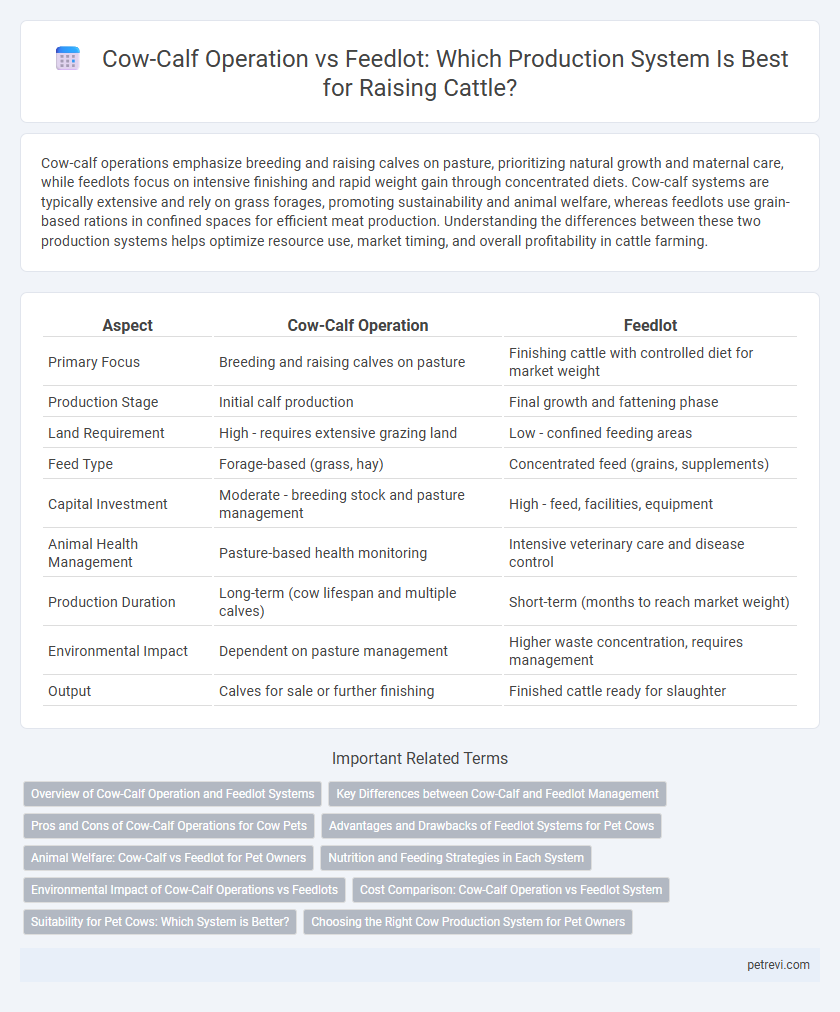Cow-calf operations emphasize breeding and raising calves on pasture, prioritizing natural growth and maternal care, while feedlots focus on intensive finishing and rapid weight gain through concentrated diets. Cow-calf systems are typically extensive and rely on grass forages, promoting sustainability and animal welfare, whereas feedlots use grain-based rations in confined spaces for efficient meat production. Understanding the differences between these two production systems helps optimize resource use, market timing, and overall profitability in cattle farming.
Table of Comparison
| Aspect | Cow-Calf Operation | Feedlot |
|---|---|---|
| Primary Focus | Breeding and raising calves on pasture | Finishing cattle with controlled diet for market weight |
| Production Stage | Initial calf production | Final growth and fattening phase |
| Land Requirement | High - requires extensive grazing land | Low - confined feeding areas |
| Feed Type | Forage-based (grass, hay) | Concentrated feed (grains, supplements) |
| Capital Investment | Moderate - breeding stock and pasture management | High - feed, facilities, equipment |
| Animal Health Management | Pasture-based health monitoring | Intensive veterinary care and disease control |
| Production Duration | Long-term (cow lifespan and multiple calves) | Short-term (months to reach market weight) |
| Environmental Impact | Dependent on pasture management | Higher waste concentration, requires management |
| Output | Calves for sale or further finishing | Finished cattle ready for slaughter |
Overview of Cow-Calf Operation and Feedlot Systems
Cow-calf operations focus on breeding cows to produce calves, which are raised on pasture until weaning, emphasizing genetics and herd health for sustainable growth. Feedlot systems take weaned calves and fatten them in confined spaces using high-energy rations to maximize weight gain before slaughter. These production systems complement each other, with cow-calf providing quality starter stock and feedlots optimizing finish efficiency for beef production.
Key Differences between Cow-Calf and Feedlot Management
Cow-calf operations primarily focus on breeding and raising calves up to weaning age, emphasizing pasture-based nutrition and reproductive management. Feedlots concentrate on finishing cattle by providing high-energy diets in confined spaces to optimize weight gain and meat quality before slaughter. Distinct management practices include long-term herd health and genetic selection in cow-calf systems versus intensive feeding regimens and growth performance monitoring in feedlots.
Pros and Cons of Cow-Calf Operations for Cow Pets
Cow-calf operations offer a natural environment that supports the health and well-being of cow pets, promoting grazing behavior and social interaction which enhance their quality of life. However, these operations require extensive land, expose animals to environmental hazards, and necessitate significant labor for management and care. While feedlots provide controlled feeding and faster growth, cow-calf systems emphasize animal welfare and sustainable production, important factors for owners valuing pet cows.
Advantages and Drawbacks of Feedlot Systems for Pet Cows
Feedlot systems for pet cows offer controlled feeding environments that enhance growth rates and allow precise nutrient management, improving overall productivity. However, the confined spaces can increase stress and susceptibility to diseases, raising health management costs. Limited natural grazing may also reduce animal welfare compared to traditional cow-calf operations.
Animal Welfare: Cow-Calf vs Feedlot for Pet Owners
Cow-calf operations prioritize natural grazing and social behaviors, promoting better animal welfare through ample space and reduced stress, ideal for pet owners concerned with ethical treatment. Feedlots, designed for rapid weight gain using confined spaces and high-energy diets, often compromise comfort and natural behaviors, which can be less appealing to those valuing animal well-being. Choosing a cow-calf system supports healthier, more humane conditions aligning with pet owners' compassion and responsibility toward animals.
Nutrition and Feeding Strategies in Each System
Cow-calf operations emphasize forage-based nutrition, relying heavily on pasture grazing and supplemental hay to meet the cow and calf energy requirements during different growth stages. Feedlots optimize feeding strategies through high-energy grain-based rations to promote rapid weight gain and feed efficiency during the finishing phase. Nutritional management in cow-calf systems prioritizes maintaining reproductive health and calf growth, while feedlot diets focus on maximizing average daily gain and feed conversion ratio using precise nutrient formulations.
Environmental Impact of Cow-Calf Operations vs Feedlots
Cow-calf operations typically exhibit lower greenhouse gas emissions per unit of beef produced compared to feedlots due to extensive grazing practices that promote carbon sequestration in pasture soils. Feedlots generate concentrated manure and higher methane emissions from grain-fed cattle, intensifying environmental pollutants such as nitrous oxide and ammonia. Incorporating improved pasture management and rotational grazing in cow-calf systems significantly mitigates soil erosion and enhances biodiversity, contrasting with the higher water usage and nutrient runoff commonly associated with feedlot operations.
Cost Comparison: Cow-Calf Operation vs Feedlot System
Cow-calf operations generally incur higher fixed costs due to pasture management and breeding expenses, while feedlot systems experience elevated variable costs driven by concentrated feed and veterinary care. Feedlots benefit from faster weight gain and shorter production cycles, reducing overall cost per pound of gain compared to cow-calf operations. Economies of scale and feed conversion efficiency are critical factors influencing the cost-effectiveness between cow-calf and feedlot production systems.
Suitability for Pet Cows: Which System is Better?
Cow-calf operations provide a more natural and spacious environment ideal for pet cows, promoting better welfare and behavioral expression compared to feedlots. Feedlots focus on intensive feeding and rapid weight gain, which can stress pet cows and limit their comfort. For pet cow owners prioritizing well-being and quality of life, cow-calf systems offer superior suitability.
Choosing the Right Cow Production System for Pet Owners
Cow-calf operations involve raising cows with their calves on pasture, promoting natural behavior and better animal welfare, making it ideal for pet owners seeking a more hands-on and nurturing environment. Feedlots focus on intensive feeding to rapidly fatten cattle for market, which may be less suitable for pet owners due to limited interaction and potential welfare concerns. Choosing the right system depends on the pet owner's goals for animal care, space availability, and desired level of involvement in daily management.
Cow-Calf Operation vs Feedlot for Cow Production System Infographic

 petrevi.com
petrevi.com